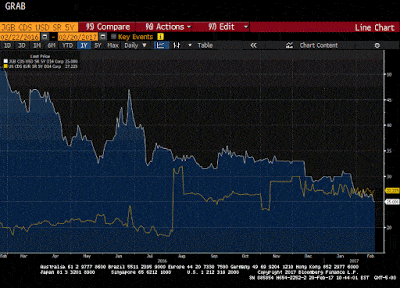This Great Graphic was created on Bloomberg and depicts Japan and US 5-year credit default swap indicative pricing. Japan's 5-year CDS is denominated in dollars and is represented by the white line. The US CDS is the yellow line and is priced in euros.
As can be seen by looking closely at the recent performance, the US CDS has risen through Japan's. This does not appear to have happened since throes of the Great Financial Crisis.
Some observers want to blame the unorthodox policies of the Trump Administration, but this does not seem right. For the first eight months of last year, the 5-year US CDS traded between 18 bp and about 24 bp. It appears to have jumped to a new and higher range in early August when it rose to almost 32 bp. Since then, it has been mostly in a 25-30 bp range. It finished last week near 27.2 bp, which is smack on the 50- and 100-day moving averages.
There was a spike to 30 bp following the unexpected results of the US election last November, but it has been trading steadily mostly in a two basis point range for last two months, despite the press conferences, executive orders, and tweets. The US is one of ten countries where the five-year CDS is quoted below 30 bp. It is difficult to call it rich. Norway looks the lowest near 20 bp. Keep in mind too that these are indicative prices and the liquidity appears uneven at best.
Japan's 5-year CDS rose from less than 20 bp in early 2008 to around 155 bp in late 2011 and early 2012. It has been trending lower since, and the low reached at the end of last week (~25 bp) is the lowest since 2008. Some have suggested that the explanation lies with the Japanese investors. They were net sellers of foreign bonds in December and January. It is the first two-month divestment since March-April 2014.
It is not immediately clear why the sales of global bonds would spur a decline in Japan's CDS. Moreover, in the December-January period, Japanese yields have risen. Consider that the 10-year JGB yield closed last July near minus 22 bp. At the end of November, it was near minus five basis points. It finished 2016 just below four basis points, the first month close in positive territory in eight months. It was near 4.5 bp at the end of January and is now near nine bp. Year-to-date the US 10-year yield is off three basis points, while the yield on the 10-year JGB is up nearly six basis points.
We do not attribute great significance to the minor crossover of the indicative pricing of the US and Japanese credit default swaps. To the extent that there is a meaningful takeaway, it would seem to be the convergence at relatively low levels--not quite pre-crisis levels, but near the lowest since then. The US 5-year CDS has increased by less than a single basis point this year, and Japan's has fallen by five. We suspect there is nothing nefarious taking place, though we will continue to monitor the situation.
Opinions expressed are solely of the author’s, based on current market conditions, and are subject to change without notice. These opinions are not intended to predict or guarantee the future performance of any currencies or markets. This material is for informational purposes only and should not be construed as research or as investment, legal or tax advice, nor should it be considered information sufficient upon which to base an investment decision. Further, this communication should not be deemed as a recommendation to invest or not to invest in any country or to undertake any specific position or transaction in any currency. There are risks associated with foreign currency investing, including but not limited to the use of leverage, which may accelerate the velocity of potential losses. Foreign currencies are subject to rapid price fluctuations due to adverse political, social and economic developments. These risks are greater for currencies in emerging markets than for those in more developed countries. Foreign currency transactions may not be suitable for all investors, depending on their financial sophistication and investment objectives. You should seek the services of an appropriate professional in connection with such matters. The information contained herein has been obtained from sources believed to be reliable, but is not necessarily complete in its accuracy and cannot be guaranteed.
Recommended Content
Editors’ Picks
EUR/USD extends gains above 1.0700, focus on key US data

EUR/USD meets fresh demand and rises toward 1.0750 in the European session on Thursday. Renewed US Dollar weakness offsets the risk-off market environment, supporting the pair ahead of the key US GDP and PCE inflation data.
USD/JPY keeps pushing higher, eyes 156.00 ahead of US GDP data

USD/JPY keeps breaking into its highest chart territory since June of 1990 early Thursday, recapturing 155.50 for the first time in 34 years as the Japanese Yen remains vulnerable, despite looming intervention risks. The focus shifts to Thursday's US GDP report and the BoJ decision on Friday.
Gold closes below key $2,318 support, US GDP holds the key

Gold price is breathing a sigh of relief early Thursday after testing offers near $2,315 once again. Broad risk-aversion seems to be helping Gold find a floor, as traders refrain from placing any fresh directional bets on the bright metal ahead of the preliminary reading of the US first-quarter GDP due later on Thursday.
Injective price weakness persists despite over 5.9 million INJ tokens burned

Injective price is trading with a bearish bias, stuck in the lower section of the market range. The bearish outlook abounds despite the network's deflationary efforts to pump the price.
Meta takes a guidance slide amidst the battle between yields and earnings

Meta's disappointing outlook cast doubt on whether the market's enthusiasm for artificial intelligence. Investors now brace for significant macroeconomic challenges ahead, particularly with the release of first-quarter GDP data.
